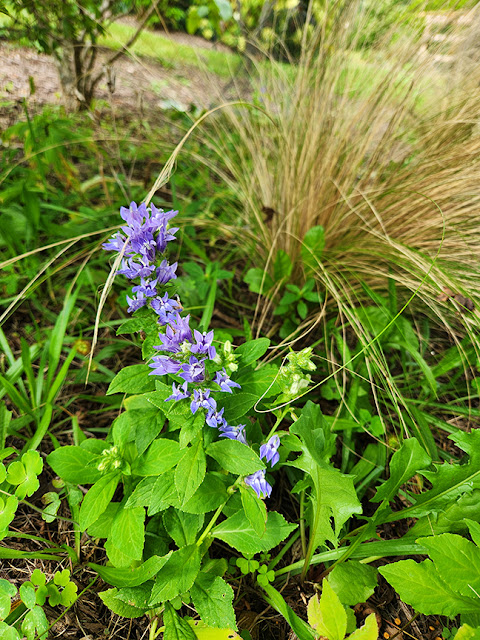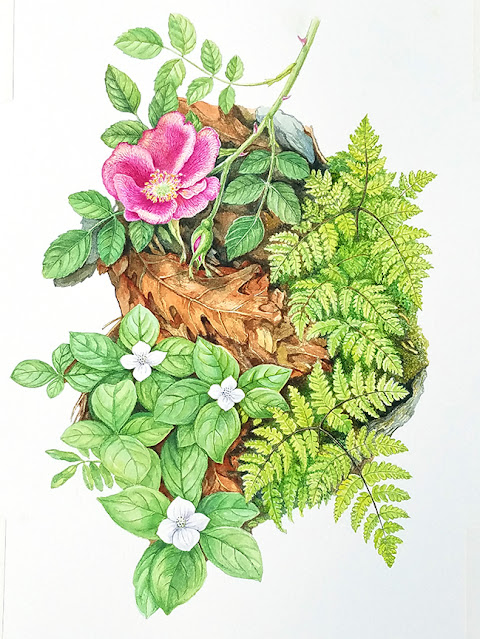 |
| Viburnum 'Brandywine' with rough green snake. |
 |
| Close-up of berries. |
This past week we've had a couple of big storms bring a lot of wind and rain--yesterday's thunderstorm dropped 1.67" of rain on my still somewhat parched garden. These late summer rains have brought out some fascinating sights that I wanted to share.
Let's start with the Viburnum 'Brandywine' berries--this is my favorite stage as they are turning pink, with a few blues here and there. Eventually they will all ripen to dark blue and then black. I took the first photo and didn't notice that there was a little green snake crawling on the branch--it wasn't until I downloaded the photos and looked at them on my computer screen that I realized that what I'd taken for a blade of grass was actually a green snake!
As I understand it, these rough green snakes (Opheodrys aestivus) eat caterpillars and other small insects, and he might have been feasting on clearwing hummingbird moth caterpillars. Viburnum is one of the host plants for this moth, and I've seen quite a few of the moths here this summer nectaring on the Asian butterfly bush. I've seen the caterpillars on previous years, but not recently. I wonder if that could be the reason why?
 |
| Clearwing hummingbird moth on Butterfly bush (photo taken by David Maza). |
The abundant rain has stimulated my 'Natchez' crape-myrtle to produce more blooms than ever before, and my Abelia 'Panoramic Color Radiance' has been sufficiently spared by the deer to offer a few blooms too.
 |
| Crape Myrtle 'Natchez' |
 |
| Abelia 'Panoramic Color Radiance' is blooming. |
The wild Petunias planted a couple of years ago keep getting eaten by the deer, but recently one of the three plants managed to offer enough flowers to appreciate its beauty. This year I grew some Mignonette (Reseda odorata) from seed. Its flowers aren't exactly showy but the scent is supposed to be wonderful. I've only detected a slight perfume, but the bees love it, so I hope it will re-seed itself for next year.
 |
| Wild Petunia (Ruellia humilis) |
 |
| Mignonette (Reseda odorata) |
Another pleasant surprise to see was that one of the two Viburnums that I grew from seed collected at Brookside Gardens had some flower buds--my Viburnums appear to be of the Leatherleaf variety or perhaps a hybrid of them--Brookside has quite a variety of Viburnums growing in that area. I'm curious to see what the flowers will be like. Let's hope the deer won't devour them--they seem to be blooming unseasonably, but some Viburnums do bloom at this time of the year.
 |
| Viburnum flower buds. |
The deer left me a few buds of the bush Clematis 'True Love' to enjoy--the color is lovely!
 |
| Clematis 'True Love' |
My double flowering quince has produced a few out of season blooms, and other summer flowers are re-blooming after being cut back: Verbascum 'Southerm Charm' and a red-hot poker.
 |
| Double-flowering quince |
 |
| Verbascum 'Southern Charm' rebloom. |
 |
| Red-hot Pokers reblooming. |
With autumn just around the corner, the Japanese Anemone 'Honorine Jobert' is developing flower buds. It lives under a protective cloche which I removed to take the photograph, but any buds that protrude from the cloche get eaten.
 |
| Anemone 'Honorine Jobert' |
The deer overlooked a few of the blue Lobelias this year--in better years I've had a gorgeous display of these native flowers which have spread over this east bed. Maybe next year?
 |
| Blue Lobelia (Lobelia siphilitica) in the east bed. |
At last, my Salvia 'Black and Blue' is blooming! This hummingbird favorite is usually grown in a pot along the front walk, and I'd never known deer to nip it before, but this year they started to munch on it at the height of the drought, so I moved it to the deck to keep it out of their reach. The pruning set it back a bit, so it only started to bloom this past week, several weeks later than usual.
 |
| Brazilian Salvia 'Black and Blue' |
I just love the color!




































